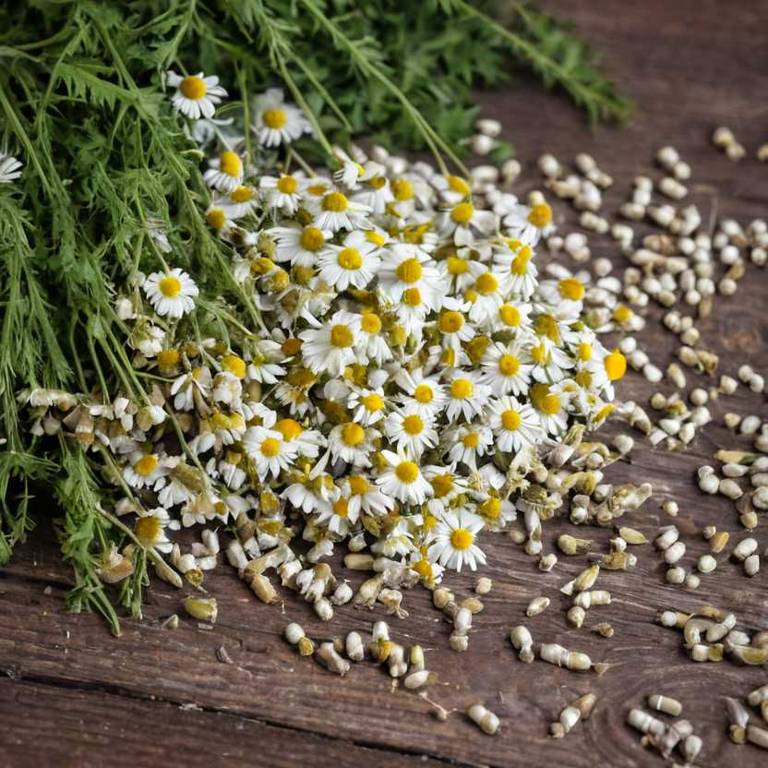10 Best Anacyclus Pyrethrum Preparations

The best medicinal preparations of Anacyclus pyrethrum are teas, tinctures, decoctions, capsules, and oils, each offering unique benefits for health and wellness.
Teas made from dried leaves can help soothe digestive issues and reduce inflammation.
Tinctures provide a concentrated form of the herb, often used for its antispasmodic properties.
Decoctions involve boiling the roots and are valued for their potency in treating respiratory and skin conditions.
Capsules offer a convenient way to consume the herb for consistent dosing.
Oils extracted from the plant are commonly used in aromatherapy and topical applications for their calming and healing effects.
Below there's a list of the 10 best herbal preparations of anacyclus pyrethrum for medicinal purposes.
1. Teas
Anacyclus pyrethrum teas is commonly used to alleviate digestive issues, reduce inflammation, and support respiratory health.
This herbal preparation is often employed to treat ailments such as indigestion, stomach cramps, bronchitis, and skin irritations. The bioactive constituents responsible for its medicinal properties include flavonoids, alkaloids, and essential oils, which possess anti-inflammatory, antimicrobial, and antispasmodic effects. These compounds work synergistically to soothe the gastrointestinal tract and reduce inflammatory responses in the body.
Additionally, the plant's volatile oils contribute to its ability to ease respiratory congestion and promote detoxification.

2. Tinctures
Anacyclus pyrethrum tinctures is commonly used to treat digestive disorders, skin conditions, and as a natural insect repellent due to its bioactive properties.
These tinctures are often employed to alleviate symptoms of indigestion, bloating, and gastrointestinal discomfort. They are also used topically for their antiseptic and anti-inflammatory effects on the skin. The medicinal properties of Anacyclus pyrethrum tinctures are attributed to compounds such as pyrethrins, which have insecticidal activity, and flavonoids, which contribute to its anti-inflammatory and antioxidant effects.
Additionally, the plant contains sesquiterpene lactones that support its therapeutic applications in traditional medicine.

3. Decoctions
Anacyclus pyrethrum decoctions is commonly used to treat digestive disorders, respiratory infections, and skin conditions.
These decoctions are widely utilized for their antispasmodic, anti-inflammatory, and antimicrobial properties. The most common ailments addressed include gastritis, coughs, asthma, and dermatitis. The bioactive constituents responsible for these effects include flavonoids, alkaloids, and essential oils.
These compounds work synergistically to provide the plant's therapeutic benefits.

4. Capsules
Anacyclus pyrethrum capsules is commonly used to support digestive health, alleviate symptoms of gastrointestinal disorders, and promote overall wellness.
The most common medicinal uses of this herbal preparation include treating indigestion, bloating, flatulence, and other digestive ailments. It is also used to address menstrual discomfort and support liver function. The bioactive constituents responsible for its medicinal properties include flavonoids, alkaloids, and essential oils, which contribute to its anti-inflammatory, antimicrobial, and carminative effects.
These compounds work synergistically to enhance digestive processes and reduce gastrointestinal distress.

5. Oils
Anacyclus pyrethrum oils is commonly used to treat skin conditions, digestive issues, and as a natural pesticide due to its potent bioactive compounds.
The most common medicinal uses include alleviating symptoms of eczema, psoriasis, and gastrointestinal disorders such as indigestion and bloating. It is also used in aromatherapy for its calming effects and to relieve stress. The bioactive constituents responsible for its medicinal properties include pyrethrin, which has insecticidal properties, and other compounds like flavonoids and essential oils that possess anti-inflammatory and antimicrobial effects.
These components work synergistically to provide the plant’s therapeutic benefits.

7. Syrups
Anacyclus pyrethrum syrups is commonly used to treat digestive disorders, respiratory infections, and skin conditions.
This herbal preparation is often employed to alleviate symptoms of indigestion, coughs, and inflammatory skin issues. The most common medicinal uses include reducing inflammation, soothing gastrointestinal discomfort, and supporting respiratory health. The bioactive constituents responsible for these effects include flavonoids, alkaloids, and essential oils, which exhibit antimicrobial, anti-inflammatory, and antispasmodic properties.
These compounds work synergistically to enhance the therapeutic benefits of the syrup.

8. Lozenges
Anacyclus pyrethrum lozenges is commonly used to alleviate symptoms of respiratory and oral infections, such as sore throat, cough, and inflammation of the throat and mouth.
These lozenges are often employed in the treatment of conditions like pharyngitis, tonsillitis, and other inflammatory conditions affecting the upper respiratory tract. The bioactive constituents responsible for these medicinal effects include essential oils, flavonoids, and alkaloids, which possess antimicrobial, anti-inflammatory, and analgesic properties. These compounds help reduce pain, swelling, and microbial activity in the affected areas.
As a result, Anacyclus pyrethrum lozenges are widely used in traditional and complementary medicine for their soothing and healing effects on the throat and mouth.

9. Creams
Anacyclus pyrethrum creams is commonly used to treat skin conditions and inflammatory disorders due to its anti-inflammatory and analgesic properties.
These creams are often applied topically to alleviate symptoms of eczema, psoriasis, and other dermatological issues. They are also used for muscle pain, joint inflammation, and minor skin irritations. The bioactive constituents responsible for these effects include essential oils, flavonoids, and alkaloids, which possess antimicrobial, anti-inflammatory, and antioxidant activities.
These compounds work synergistically to reduce swelling, soothe irritation, and promote skin healing.

10. Linctuses
Anacyclus pyrethrum linctuses is commonly used to relieve respiratory symptoms such as coughing, bronchitis, and asthma.
This herbal preparation is often employed to treat ailments related to the respiratory tract, including inflammation of the airways and excessive mucus production. The bioactive constituents responsible for its medicinal properties include alkaloids, flavonoids, and essential oils, which possess anti-inflammatory, expectorant, and bronchodilator effects. These compounds help reduce irritation in the respiratory system and ease breathing.
Due to its soothing and cleansing actions, it is also used to alleviate throat discomfort and support overall respiratory health.
